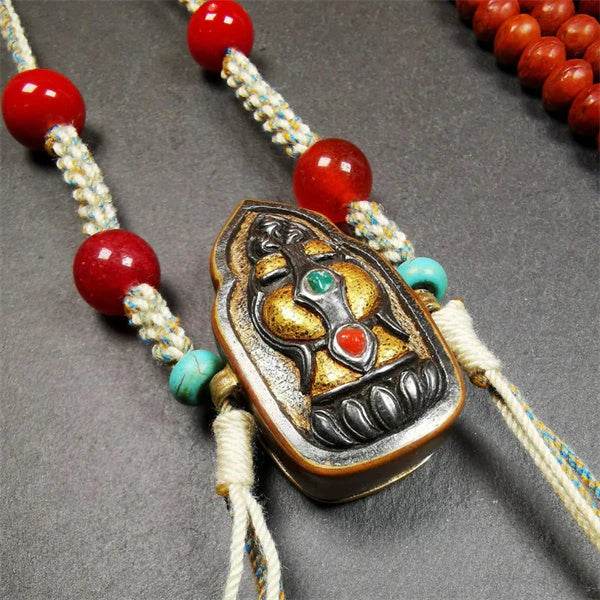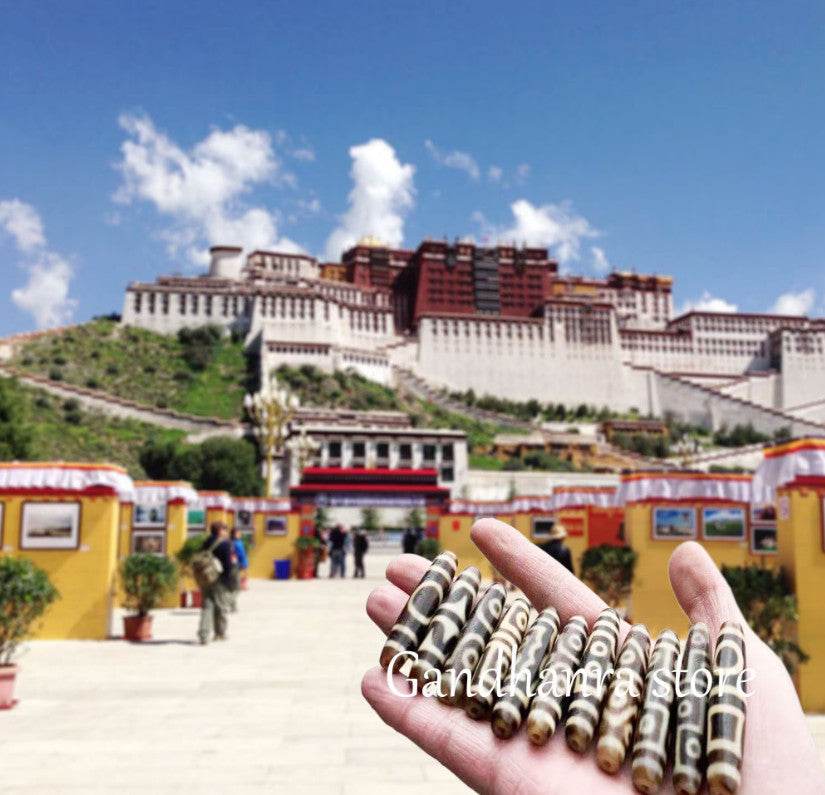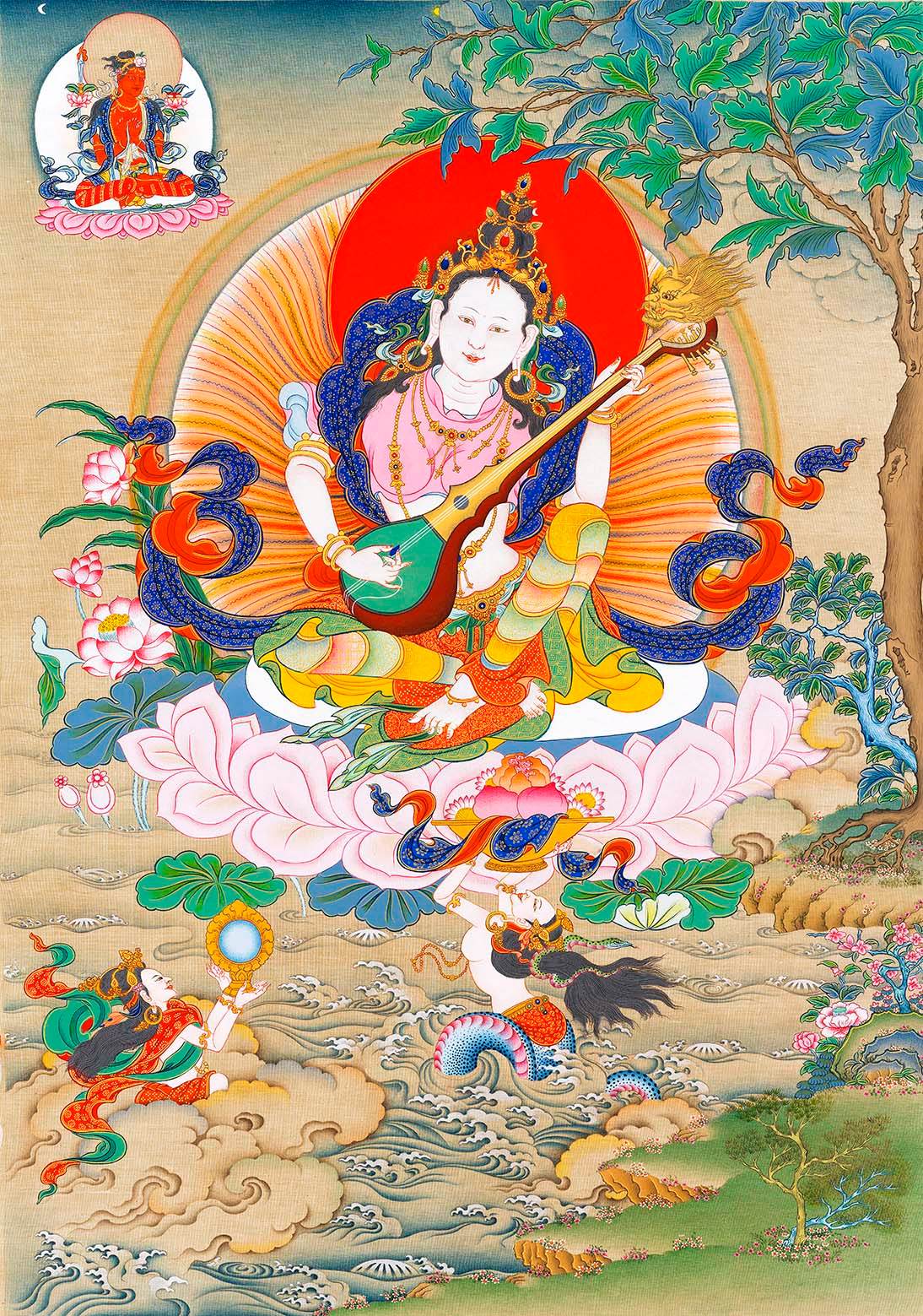
The Sport and Culture at Your Fingertips ▎An Interview on Tibetan Carom

Portrait of Jie Zixia·Maima Dunzhu
(Image Source: Jie Zixia)
Jie Zixia · Maima Dunzhu was born in 1974 on Barkhor Street in Lhasa. He developed a connection with this sport from a young age, and his passion for it has never waned over fifty years. From establishing the "Jie Zixia" competitive space to improving equipment and formulating official rules, and further to successfully promoting the establishment of the "Tibet Autonomous Region Tibetan Carom Association" in 2023, he has transformed a personal interest into a standardized undertaking. He is dedicated to bringing this fingertip sport, imbued with Tibetan wisdom, from teahouses and taverns to a broader world.

Image Source: Jie Zixia
Childhood in the Barkhor Alleys
I was born in 1974 on the third floor of Samdrup Podrang (བསམ་གྲུབ་ཕོ་བྲང་།) on Barkhor Street in Lhasa. At that time, Samdrup Podrang was the location of the Lhasa Agricultural Machinery Company, where my father worked and also had his staff dormitory. My father came from Gyalse Shar (རྒྱལ་རྩེ་ཤར།), a ancestral home located in the northern part of the old city of Lhasa.

Samdrup Podrang
(Image Source: Jie Zixia)
The social atmosphere of my childhood, in my memory, was a wonderful era (བསྐལ་པ་བཟང་པོ།). The economy was gradually developing, society was becoming increasingly stable, and especially, the new vibes of reform and opening-up began to emerge. I grew up in the Barkhor Street area and later attended Barkhor Primary School.

Barkhor Street Scene
(Image Source: National Geographic)
Family gatherings were frequently held at home, with relatives and friends visiting often, and a continuous stream of guests. Although there was a period when card games were banned in the late 1960s, by my childhood, some had already started playing Tibetan cards at family gatherings.

Citizens Playing Cards
(Image Source: National Geographic)
Children's games were not greatly affected during that period. Games such as Ajug (ཨ་ཅུག), Boli Ball (འབོ་ལི།), and Shuttlecock Kicking (ཐེབས་པད།) remained popular, while kite flying (བྱ་འཕིར།) also became active in children's daily lives with the changing seasons.

Boys Flying Kites
(Image Source: National Geographic)
Connection with Carom
Tibetan Carom originated from the South Asian game of Carrom. Legend has it that this game was invented by a South Asian maharaja to please his consort, and the world's first Carom table was made of glass. To this day, an early Carom board with a glass surface is still preserved in a palace in Patiala, South Asia.

Arabs Playing Carom
(Image Source: Jie Zixia)
The game of Carrom gradually spread to South Asia and other regions, and was introduced to Tibet through Kashmiri merchants. In Tibet, the game underwent a prolonged process of localization, developing unique equipment standards and competitive rules, eventually evolving into "Tibetan Carom."

Traditional Tibetan Carom Table
(Image Source: Jie Zixia)
The standard pocket diameter is 3 cm, with disc thickness not exceeding 4.5 cm and diameter approximately 2.6 cm. They are typically crafted from high-density natural wood, differing from the plastic materials commonly used in South Asian Carrom. Furthermore, during the Victorian era, Sikhs introduced Carom to Shanghai with the British troops, leading to the development of the cue-based game Kangle, which distinctly differs from Tibetan Carom.

Officials Watching a Carom Match
Tingcha·Dorje Gyaltsen
(Image Source: Jie Zixia)
The related terminology incorporates elements from multiple languages, including Tibetan, Chinese, English, and various South Asian languages. As a result, this sport gradually formed an entirely new category of game in Tibet, which we refer to as "Tibetan Carom," with its correct pronunciation established as "Carrom" (Tibetan: ཀེ་རོམ།).

Carom Pastime in Tsarong House
(Image Source: Jie Zixia)
My first encounter with Carom happened during a gathering at my home. A guest brought a Carom table, and naturally, my young self was intensely curious. At that time, I wasn't tall enough to reach the table and had to stand to strike the discs. That was when I first connected with Carom and quickly developed a deep interest in it.

Maima Dunzhu
(Image Source: The Third Pole of the Earth)
After my father learned about my fondness for Carom, he specially hired a carpenter to make a small Carom table for me. The only shortcoming was that this table lacked the hanging pockets beneath the pockets and the accompanying discs. So, we used coins of different denominations, painted them in different colors, and used them as the striker and discs.

Maima Dunzhu and His Modern Carom Table
(Image Source: Sacred Mountain)
From then on, my friends and I played Carom whenever we had time. We even brought it to school, hiding it under the ping pong table to play during breaks and lunch, then taking it home after school. That Carom table held extraordinary significance for me. In those days, people's entertainment options were relatively limited—unlike today where everyone has a mobile phone. Even television was only an occasional pastime for a few families, and its use had to align with the power supply schedule. Even with the abundance of entertainment options available today, Carom remains active among people. Needless to say, back in those days, the passion it ignited in my younger self is something words can hardly fully express.

Classroom in Lhasa
(Image Source: Lhasa Today)
At that time, Carom was deeply loved by the children of Lhasa. The game itself is highly competitive, and whenever we pocketed a disc, scored, and ultimately won—to put it in modern terms—it undoubtedly released a large amount of dopamine in our brains. Back then, we naturally didn't think about cultural heritage or responsibilities under grand narratives; what we felt more was the thrill and sense of achievement brought by competition.

Carom Details
(Image Source: The Third Pole of the Earth)
Especially during the long summer days in the mid-1980s, my friends and I would rush to the Tsangmu Sweet Teahouse in the Hêbalin area—Abla Teahouse—to play Carom to our hearts' content after school. Later, because the elder Abla passed away, to avoid using his name directly, and since Carom enthusiasts gathered in the teahouse like "Liangshan's heroic assembly," society gave the teahouse the nickname "Liangshan."

Lhasa Teahouse
(Image Source: Lhasa Today)
However, in the social climate of that time, frequent visits to teahouses were often seen as idling away one's time, so I had to secretly hide it from my family when I went. In 1986, I went to Lintong, Shaanxi, for junior high school, but our Carom games didn't stop. At school, we found a Kangle table and used polished Chinese chess pieces as substitutes for Carom discs, allowing us to continue playing with undiminished enthusiasm.

Tibetan Carom
(Image Source: Enjoy Lhasa)
In 1989, I returned to Lhasa and attended Lhasa Middle School for high school. I often played Carom at the "Friends and Relatives Teahouse" in the Xue District. Initially, we practiced on beginner-level tables, and as our skills improved, we gradually moved to competing on professional tables until the Friends and Relatives Teahouse closed down. Later, after starting work at a real estate company, I still made time to play Carom with friends.

Maima Dunzhu Competing with Friends
(Image Source: Jie Zixia)
Establishing the Association
In the 1990s, with the expansion of Lhasa city and population growth, the social landscape took on a new look, but Carom remained primarily a pastime in teahouses and taverns without deeper development or improvement. Around that time, I also left the real estate company and started my own business, investing the accumulated funds into advancing Carom initiatives, including the startup capital for establishing venues like the Jie Zixia Café. At the same time, I also regarded this endeavor as a for-profit undertaking.

Jie Zixia Café
(Image Source: Jie Zixia)
In 2018, I founded the Jie Zixia Café, offering customers beverages like coffee while providing a venue for Carom competitions. I also set up a workshop to sell high-quality Carom tables and organize tournaments. By 2022, we had successfully held four or five large-scale events.

Carom Promotion Event
(Image Source: Enjoy Lhasa)
These activities gradually brought Carom from taverns and teahouses to all sectors of society, receiving widespread acclaim, and orders from various Carom manufacturers gradually increased. Personally passionate about invention and creation, driven by my love for Carom, I began to improve the traditional equipment, including upgrading the traditional pockets and hanging bags to pull-out metal boxes. This greatly optimized the competitive experience, as players no longer needed to struggle to retrieve discs from narrow pockets.

Modern Carom Pocket
(Image Source: Jie Zixia)
We cannot claim ownership of the existing Carom table designs in society, nor do they fully meet professional requirements. Therefore, we created new table designs and applied for patents. To date, we have successfully obtained four or five related intellectual property patents.

Modern Carom Table
(Image Source: Jie Zixia)
However, promoting the Carom initiative solely through my personal efforts and financial resources was very challenging. Therefore, we conceived the idea of establishing a professional Carom association. With the support of various departments, we officially founded the "Tibet Autonomous Region Tibetan Carom Association" on May 27, 2023, and obtained the formal national qualification on June 14 of the same year.

Establishment Ceremony of the Tibet Autonomous Region Carom Association
(Image Source: Jie Zixia)
Between 2020 and 2021, we recognized the need to establish official game rules and therefore invited forty-four professionals in the field of Carom to discuss and vote together. Starting from the basics of a patternless table, we discussed the table's form, surface design, scoring rules, and other aspects one by one, ultimately summarizing this set of official rules through voting.

Tibetan Carom Rules - Table Specifications
(Image Source: Jie Zixia)

Ancient skills from southern lands crossed vast frontiers,
Spreading to the snow-clad realms, new life appears.
Carom's elegant game inherits Tibet's rhyme,
Its innate spirit shines with a light for our time.
—Composed by Jie Zixia · Maima Dunzhu
In my view, a set of standardized rules is crucial for the inheritance and development of traditional ethnic sports. Looking back at the history of Carom, according to the research of the renowned scholar Dogon·Sandadoje, it has a history of one hundred and fifty years. It originated in South Asia, was introduced to Tibet through various opportunities, and developed new competitive rules through interactions with different ethnic groups in Tibet, along with innovations in the design of the playing table.

Mr. Dogon · Sandadoje Competing at Jie Zixia
(Image Source: Jie Zixia)
If competitors from South Asia were to tell us, "Your game originated from us, and your rules are incorrect," although we respect its status as the place of origin, we also need a standard official document to confirm that our Carom possesses distinct Tibetan characteristics. At the same time, the term "Tibetan-style" emphasizes that it is a product of the diverse cultural exchanges in Tibet. Documenting this historical fact holds profound significance.

Tibetan Carom Rules - Offline Discs
(Image Source: Jie Zixia)
As the president, the association currently focuses on organizing regular weekly Carom competitions, hosting officially designated events and tournaments, and actively participating in various unofficial activities. For example, at this year's Sacred Mountain Summer Lingka event, we promoted this traditional sport to a broad youth audience. The significance of the association lies not only in establishing official rules and promoting the sport of Carom but also in respecting the work of other high-quality Carom manufacturers in the Lhasa area, honoring the traditions of Carom, and maintaining consistency in design with them.

Tibetan Carom Promotion Event
(Image Source: Jie Zixia)
Looking to the Future
I believe Carom is a game full of Tibetan elegance and cultural richness, where the fingertip skills and social interactions during play contain profound cultural significance. However, in the past, society once regarded it as an exclusive game for the upper class.

Tibetan Carom in the Teahouse
(Image Source: Tibet Daily)
The upper class, with their financial means, naturally had greater access to Carom tables, but this gradually evolved into an inappropriate notion that commoners were prohibited from participating. Additionally, because Carom long thrived in teahouses and taverns, and due to the stereotypes associated with such venues, some families once forbade their children from playing Carom in teahouses. I am deeply grateful to my parents, who always supported my involvement in this sport.

Maima Dunzhu in Front of Jie Zixia Café
(Image Source: Jie Zixia)
This year I turned fifty and still rarely need to wear glasses. I believe this is closely related to my childhood, which lacked video games and was filled with ample spare time devoted to Carom and other outdoor activities. Children today, growing up in a broader environment, are prone to becoming addicted to mobile phones and social media, lacking outdoor exercise, leading to a sharp increase in student myopia rates.

Carom Activities for Children
(Image Source: Jie Zixia)
Against this backdrop, if the sport of Carom can gain attention and spark interest among young people, it can first help exercise hand-eye coordination. Secondly, Carom is not simply about pocketing discs; the strategic planning, situation prediction, and problem-solving techniques involved contain profound knowledge, which greatly benefits adolescents' mental development. Recently, an increasing number of parents have begun purchasing Carom tables for their children's entertainment. I have also conducted voluntary Carom interest classes to teach young children.

Carom Activities for Children
(Image Source: Jie Zixia)
Our association has organized numerous Carom promotion activities among young people to date, creating many educational videos on Douyin and video channels to promote the sport. Additionally, while maintaining the traditional design, we need to focus on the experience of beginners, especially in the current competitive landscape of various entertainment activities. Making appropriate adjustments, such as fine-tuning the size of the pockets, can encourage them to try it out and invest time in it.

Carom Competition Among Hospital Staff
(Image Source: Jie Zixia)
In some regions of Tibet, there used to be claims that women should not participate in certain games, such as "Shog" dice, and some also asserted that women could not play Carom. Places like teahouses and taverns were considered improper for women to visit. I believe these claims are completely unfounded and utterly meaningless. Later, I also debunked these assertions through expert research. They consulted a vast number of classical texts and found no such restrictions.

Several Women Playing Carom
(1940s, Image Source: Jie Zixia)
Society is developing, and the times are progressing: with the increase in participants, venues like teahouses, where women were once criticized for visiting, are now freely accessible to anyone for leisure. The same applies to the sport of Carom. I believe we must adapt and evolve in this regard.

Female Presence in Modern Carom Competitions
(Image Source: Jie Zixia)
Carom and similar games have spread to over forty countries worldwide. Tibetan Carom embodies the wisdom of various ethnic groups in Tibet and is a highly valuable sport. In the future, we will continue to improve and develop the sport of Carom, refining the game rules and strengthening the association.

Carom Competition in Pakistan
(Image Source: Jie Zixia)
In the digital age, we will leverage high-quality promotional methods to first promote and compete in Tibet, then expand to other regions within the country, and even go international. Through the joint efforts of enthusiasts across generations, we will foster international exchange and friendly competition, and even discuss unified competitive rules, ultimately making Carom an international sport. This is my greatest vision.

(Image Source: Jie Zixia)






